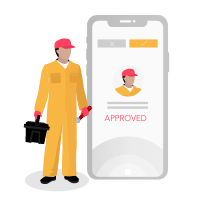What is a Visitor Management System?
A Visitor Management System is a technology used to track, monitor, and manage visitors in a building or amenity. Visitor Management Systems for society are developed to provide security, improve visitor experience, and hassle free check-in process.
Key Features Of Visitor Management System
A Guest/Visitor Management system software offers a range of features designed for visitor registration, enhance security, and improve the overall visitor experience. Key features include:
| Registration and Check-In | With Visitor Management Systems, Visitors can pre-register or check in on arrival using a kiosk, tablet, or smartphone. |
| Visitor Badges | Temporary badges are issued to visitors for identification and access control. |
| Notifications | Hosts are notified when their visitors arrive. |
| Security | Enhances security by keeping a record of all visitors and their activities. Visitor management system provides safety and security to the users. |
| Visitor Logs | Visitor management system maintains detailed logs of visitor information, including time of entry and exit. |
| Compliance | Visitor management system helps organizations comply with regulations regarding visitor tracking and data protection. |
| Customization | Customizable workflows and check-in processes to fit the specific needs of an organization. |
| Integration | Visitor Management System can integrate with other systems such as access control, security, and HR systems. |
| Visitor Screening | Pre-screening visitors for security purposes and health checks. |
| Reporting | Provides detailed reports and analytics on visitor data. |
Benefits Of Best Visitor Management System
Implementing a best VMS Visitor Management System provides security and numerous advantages, including improved visitor experience, efficient management, and regulatory compliance. Key benefits include:
| Enhanced Security | Visitor Management System provides better control over who enters the premises, reducing the risk of unauthorized access. |
| Improved Visitor Experience | Streamlines the check-in process, reducing wait times and improving the visitor experience. |
| Efficient Management | Automates and digitizes the visitor management process, reducing manual work and errors. |
| Data Accuracy | Ensures accurate and up-to-date visitor information. |
| Regulatory Compliance | Visitor Management System, helps in adhering to legal and regulatory requirements for visitor tracking. |
| Resource Optimization | Frees up staff time by automating the check-in process. |
| Professional Image | Creates a positive impression with a smooth and modern check-in process. |
Why Visitor Management System?
Handling Visitors Made Easy:
VMS Visitor Management System simplifies visitor management. Keep your community safe and operations smooth by choosing a VMS which adapts to changes.
Prioritize Security and Efficiency:
By leveraging a VMS Visitor Management System you are prioritizing the safety and efficiency of your society’s operations. Gain peace of mind through robust tools that safeguard employees, assets, and intellectual property.
Enhance Visitor Experiences:
NoBrokerHood VMS Visitor Management System will strengthen ties with residents, partners, and stakeholders, enhancing our society’s reputation and unity.
How Does A Visitor Management Software Work?
A visitor management software/ app operates through a streamlined process designed to enhance security and improve visitor experience. Here’s how it typically works:
- Invite Your Visitor
- Visitor Sign-In
- Background Security Screening
- Host Notification
- Greeting the Visitor
Step 1: Invite Your Visitor
When you schedule a visit, the visitor management software/ app sends an automatic notification to your guest via email. This message includes essential information such as directions to your location, a link to submit health verification details, and any safety protocols they need to follow while onsite.
Step 2: Visitor Sign-In
Upon arrival, your visitor signs in using an app on their phone or a tablet at the reception. During this step, they input their name and other relevant details, take a photo, and digitally sign any required documents.
Step 3: Background Security Screening
In the background, the visitor management software/ app performs security checks. It screens visitors against block lists, watchlists, and verifies IDs to ensure that everyone entering the premises is authorized.
Step 4: Host Notification
Once the visitor has signed in, the system automatically notifies the appropriate employee that their guest has arrived, streamlining communication and reducing waiting time.
Step 5: Greeting the Visitor
With the notification received, the employee can promptly greet their guest in the lobby, ensuring a smooth and professional introduction without any awkwardness.
By automating these steps, a visitor management software not only boosts security but also enhances the overall visitor experience, making the process efficient and welcoming.
Also Check: Society Management System
Future Trends in Visitor Management Software/ App
1. Advanced Technology Integration
AI and Machine Learning: Visitor Management System use AI to enhance visitor screening and predict visitor patterns.
Facial Recognition: Visitor Management System implement facial recognition technology for seamless check-ins and enhanced security.
2. Mobile Integration
Mobile Check-In: Society Visitor Management Software, allows visitors to check in using their smartphones, reducing the need for physical kiosks.
Digital Passes: Visitor management system for society issue digital passes and badges that can be stored on mobile devices.
3. Enhanced Data Privacy
Data Protection Regulations: Visitor management software adhere to evolving data protection regulations to ensure visitor data is handled securely.
Privacy Features: Visitor management software implement features that allow visitors to manage their data preferences.
Why Use NoBrokerHood Best Visitor Management Systems (VMS)
Boosted Security Measures
- Multi-factor Authentication for better security: With our best visitor management system , you can implement multi-factor authentication and integrate it with your existing security systems, ensuring a fortified security perimeter.
- Real-Time monitoring to ensure swift response: With our visitor management system stay in control even in the case of unexpected security breaches or anomalies.
- These robust security measures not only safeguard your premises but also protect sensitive data, maintaining the integrity and confidentiality of your business operations.
Streamlined Visitor Experience
- The end-to-end streamlined visitor experience extends to Visitor Management System registration and badge printing, effectively eliminating long queues and tedious processes, ensuring a swift and hassle-free check-in process for your guests.
- This improved efficiency not only saves valuable time but also reflects your commitment to delivering a top-notch visitor experience.
Compliance and Reporting Ease
- Our VMS visitor management system simplifies compliance by providing a centralized repository for visitor data, making it easy to generate reports for auditing and regulatory purposes.
- This centralization ensures that all visitor information is securely stored and readily accessible, aiding in compliance with data privacy regulations such as GDPR, HIPAA, and CCPA.
- Additionally, the reporting capabilities within our Society Visitor Management System offer insights into visitor trends and patterns, enhancing overall security and visitor management strategies.














